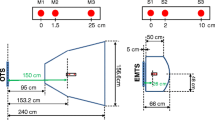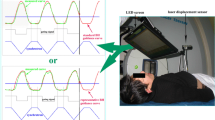Abstract
Describe a Web-based wireless visual guidance system that mitigates issues associated with hard-wired audio-visual aided patient interactive motion management systems that are cumbersome to use in routine clinical practice. Web-based wireless visual display duplicates an existing visual display of a respiratory-motion management system for visual guidance. The visual display of the existing system is sent to legacy Web clients over a private wireless network, thereby allowing a wireless setting for real-time visual guidance. In this study, active breathing coordinator (ABC) trace was used as an input for visual display, which captured and transmitted to Web clients. Virtual reality goggles require two (left and right eye view) images for visual display. We investigated the performance of Web-based wireless visual guidance by quantifying (1) the network latency of visual displays between an ABC computer display and Web clients of a laptop, an iPad mini 2 and an iPhone 6, and (2) the frame rate of visual display on the Web clients in frames per second (fps). The network latency of visual display between the ABC computer and Web clients was about 100 ms and the frame rate was 14.0 fps (laptop), 9.2 fps (iPad mini 2) and 11.2 fps (iPhone 6). In addition, visual display for virtual reality goggles was successfully shown on the iPhone 6 with 100 ms and 11.2 fps. A high network security was maintained by utilizing the private network configuration. This study demonstrated that a Web-based wireless visual guidance can be a promising technique for clinical motion management systems, which require real-time visual display of their outputs. Based on the results of this study, our approach has the potential to reduce clutter associated with wired-systems, reduce space requirements, and extend the use of medical devices from static usage to interactive and dynamic usage in a radiotherapy treatment vault.




Similar content being viewed by others
References
Keall PJ, Mageras GS, Balter JM et al (2006) The management of respiratory motion in radiation oncology report of AAPM task group 76. Med Phys 33(10):3874–3900
Kim T, Pollock S, Lee D, O’Brien R, Keall P (2012) Audiovisual biofeedback improves diaphragm motion reproducibility in MRI. Med Phys 39(11):6921–6928
Lee D, Greer PB, Ludbrook J et al (2016) Audiovisual biofeedback improves cine—magnetic resonance imaging measured lung tumor motion consistency. Int J Radiat Oncol Biol Phys 94(3):628–636
Cervino LI, Gupta S, Rose MA, Yashar C, Jiang SB (2009) Using surface imaging and visual coaching to improve the reproducibility and stability of deep-inspiration breath hold for left-breast-cancer radiotherapy. Phys Med Biol 54(22):6853
George R, Chung TD, Vedam SS et al (2006) Audio-visual biofeedback for respiratory-gated radiotherapy: impact of audio instruction and audio-visual biofeedback on respiratory-gated radiotherapy. Int J Radiat Oncol Biol Phys 65(3):924–933
George R, Vedam S, Chung T, Ramakrishnan V, Keall P (2005) The application of the sinusoidal model to lung cancer patient respiratory motion. Med Phys 32(9):2850–2861
Cui G, Gopalan S, Yamamoto T, Berger J, Maxim PG, Keall PJ (2010) Commissioning and quality assurance for a respiratory training system based on audiovisual biofeedback. J Appl Clin Med Phys 11(4):3262
Nakajima Y, Kadoya N, Kanai T et al (2016) Comparison of visual biofeedback system with a guiding waveform and abdomen-chest motion self-control system for respiratory motion management. J Radiat Res 57(4):387–392
Park Y-K, Kim S, Kim H, Kim IH, Lee K, Ye S-J (2011) Quasi-breath-hold technique using personalized audio-visual biofeedback for respiratory motion management in radiotherapy. Med Phys 38(6):3114–3124
Ju H, Kim S, Read P et al. Development of a novel remote-controlled and self-contained audiovisual-aided interactive system for immobilizing claustrophobic patients. J Appl Clin Med Phys 2015;16(3)
Barrett JF, Keat N (2004) Artifacts in CT: recognition and avoidance 1. Radiographics 24(6):1679–1691
Brock J, McNair HA, Panakis N, Symonds-Tayler R, Evans PM, Brada M (2011) The use of the active breathing coordinator throughout radical non—small-cell lung cancer (nsclc) radiotherapy. Int J Radiat Oncol Biol Phys 81(2):369–375
Wong JW, Sharpe MB, Jaffray DA et al (1999) The use of active breathing control (ABC) to reduce margin for breathing motion. Int J Radiat Oncol Biol Phys 44(4):911–919
Clinic M. Wireless technology does not affect pacemakers and defibrillators. Available from URL: http://www.news-medical.net/news/2004/12/22/7002.aspx [Accessed 2 Oct 2016]
Jin J-Y, Yin F-F, Tenn SE, Medin PM, Solberg TD (2008) Use of the BrainLAB Exactrac X-Ray 6D system in image-guided radiotherapy. Med Dosim 33(2):124–134
Noble DJ, MacDowell CJ, McKinnon ML, Neblett TI, Goolsby WN, Hochman S. Use of electric field sensors for recording respiration, heart rate, and stereotyped motor behaviors in the rodent home cage. J Neurosci Methods 2016
Acknowledgements
This project was partially supported by Institutional Research Grant IRG-14-192-40 from the American Cancer Society. The authors thank Katherine Goracke for reviewing this paper for clarity. Taeho Kim, Siyong, Kim and Danny Lee are inventors on U.S. Provisional Patent 62/375,554 related to Real-Time Web-Based Wireless Visual Guidance for the goal of a wireless and mountless visual guidance solution.
Author information
Authors and Affiliations
Corresponding author
Ethics declarations
Conflict of interest
The authors declare that they have no conflicts of interest.
Ethical approval
This article does not contain any studies with human participants or animals performed by any of the authors.
Rights and permissions
About this article
Cite this article
Lee, D., Kim, S., Palta, J.R. et al. Technical note: real-time web-based wireless visual guidance system for radiotherapy. Australas Phys Eng Sci Med 40, 463–469 (2017). https://doi.org/10.1007/s13246-017-0548-0
Received:
Accepted:
Published:
Issue Date:
DOI: https://doi.org/10.1007/s13246-017-0548-0




